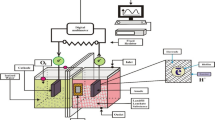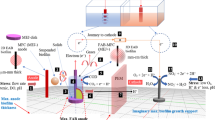Abstract
Simultaneous power generation and fecal wastewater treatment were investigated using a combined ABR-MFC-MEC system (anaerobic baffled reactor-microbial fuel cell-microbial electrolysis cell). The installation of multi-stage baffles can benefit retaining the suspended solids in the system and help separate the hydrolysis-acidification and the methanogen processes. The efficiencies of the nitrification-denitrification process were improved because of the weak current generation by coupling the microbial electrochemical device (MFC-MEC) with the ABR unit. Maximum removal rates for chemical oxygen demand (COD) and ammonia nitrogen (NH4 +-N) were 1.35 ± 0.05 kg COD/m3/day and 85.0 ± 0.4 g NH4 +-N/m3/day, respectively, while 45% of methane (CH4), 9% of carbon dioxide (CO2), and 45% of nitrogen gas (N2) contents in volume ratio were found in the collected gas phase. An average surplus output voltage of 452.5 ± 10.5 mV could be achieved from the combined system, when the initial COD concentration was 1500.0 ± 20.0 mg/L and the initial NH4 +-N concentration was 110.0 ± 5.0 mg/L, while the effluent COD could reach 50.0 mg/L with an HRT of 48 h. The combined process has the potential to treat fecal wastewater efficiently with nearly zero energy input and a fair bio-fuel production.






Similar content being viewed by others
References
American Public Health Association (APHA), A.W.W.A.A., Water Environment Federation (WEFW). (1998). Standard Methods for the Examination of Water and Wastewater. 20th ed, Washington, DC.
Anand, C. K., & Apul, D. S. (2014). Composting toilets as a sustainable alternative to urban sanitation--a review. Waste Management, 34(2), 329–343.
Biache, C., Frometa, A. E., Czechowski, F., Lu, Y., & Philp, R. P. (2015). Thiosteranes in samples impacted by fecal materials and their potential use as marker of sewage input. Environmental Pollution, 196, 268–275.
Chang, I. S., Moon, H., Jang, J. K., & Kim, B. H. (2005). Improvement of a microbial fuel cell performance as a BOD sensor using respiratory inhibitors. Biosensors & Bioelectronics, 20(9), 1856–1859.
Cheng, S., Kiely, P., & Logan, B. E. (2011). Pre-acclimation of a wastewater inoculum to cellulose in an aqueous-cathode MEC improves power generation in air-cathode MFCs. Bioresource Technology, 102(1), 367–371.
Cheng, S., & Logan, B. E. (2011). High hydrogen production rate of microbial electrolysis cell (MEC) with reduced electrode spacing. Bioresour Technology, 102(3), 3571–3574.
Diak, J., Ormeci, B., & Kennedy, K. J. (2013). Effect of micro-aeration on anaerobic digestion of primary sludge under septic tank conditions. Bioprocess and Biosystems Engineering, 36(4), 417–424.
Escapa, A., Gomez, X., Tartakovsky, B., & Moran, A. (2012). Estimating microbial electrolysis cell (MEC) investment costs in wastewater treatment plants: Case study. International Journal of Hydrogen Energy, 37(24), 18641–18653.
Feng, Y., Lee, H., Wang, X., Liu, Y., & He, W. (2010). Continuous electricity generation by a graphite granule baffled air-cathode microbial fuel cell. Bioresource Technology, 101(2), 632–638.
Glorina P.Orozco, M.T.Z. 2012. Biophysico-chemical and socioeconomic study of two Major Manila Esteros. Biology Education for Social and Sustainab, 161–171.
Hengjing Yan, J. M. R. (2013). Enhanced nitrogen removal in single-chamber MFC with incraesed gas diffusion areas. Biotechnology and Bioengineering, 110(3), 785–790.
Hill, G. B., & Baldwin, S. A. (2012). Vermicomposting toilets, an alternative to latrine style microbial composting toilets, prove far superior in mass reduction, pathogen destruction, compost quality, and operational cost. Waste Management, 32(10), 1811–1820.
Jia, Y. H., Choi, J. Y., Ryu, J. H., Kim, C. H., Lee, W. K., Tran, H. T., Zhang, R. H., & Ahn, D. H. (2010). Hydrogen production from wastewater using a microbial electrolysis cell. Korean Journal of Chemical Engineering, 27(6), 1854–1859.
Kiely, P. D., Cusick, R., Call, D. F., Selembo, P. A., Regan, J. M., & Logan, B. E. (2011). Anode microbial communities produced by changing from microbial fuel cell to microbial electrolysis cell operation using two different wastewaters. Bioresource Technology, 102(1), 388–394.
Kim, I. S., Hwang, M. H., Jang, N. J., Hyun, S. H., & Lee, S. T. (2004). Effect of low pH on the activity of hydrogen utilizing methanogen in bio-hydrogen process. International Journal of Hydrogen Energy, 29(11), 1133–1140.
Kuntke, P., Smiech, K. M., Bruning, H., Zeeman, G., Saakes, M., Sleutels, T. H., Hamelers, H. V., & Buisman, C. J. (2012). Ammonium recovery and energy production from urine by a microbial fuel cell. Water Research, 46(8), 2627–2636.
Lalander, C. H., Hill, G. B., & Vinneras, B. (2013). Hygienic quality of faeces treated in urine diverting vermicomposting toilets. Waste Management, 33(11), 2204–2210.
Li, J., Liu, G., Zhang, R., Luo, Y., Zhang, C., & Li, M. (2010). Electricity generation by two types of microbial fuel cells using nitrobenzene as the anodic or cathodic reactants. Bioresource Technology, 101(11), 4013–4020.
Liu, Z. D., & Li, H. R. (2007). Effects of bio- and abio-factors on electricity production in a mediatorless microbial fuel cell. Biochemical Engineering Journal, 36(3), 209–214.
Logan, B. E., & Regan, J. M. (2006). Electricity-producing bacterial communities in microbial fuel cells. Trends in Microbiology, 14(12), 512–518.
Min, B., Roman, O. B., & Angelidaki, I. (2008). Importance of temperature and anodic medium composition on microbial fuel cell (MFC) performance. Biotechnology Letters, 30(7), 1213–1218.
Mohan, S. V., Mohanakrishna, G., Srikanth, S., & Sarma, P. N. (2008). Harnessing of bioelectricity in microbial fuel cell (MFC) employing aerated cathode through anaerobic treatment of chemical wastewater using selectively enriched hydrogen producing mixed consortia. Fuel, 87(12), 2667–2676.
Oarga Mulec, A., Mihelič, R., Walochnik, J., & Griessler Bulc, T. (2016). Composting of the solid fraction of blackwater from a separation system with vacuum toilets – Effects on the process and quality. Journal of Cleaner Production, 112, 4683–4690.
Pirsaheb, M., Rostamifar, M., Mansouri, A. M., Zinatizadeh, A. A. L., & Sharafi, K. (2015). Performance of an anaerobic baffled reactor (ABR) treating high strength baker's yeast manufacturing wastewater. Journal of the Taiwan Institute of Chemical Engineers, 47, 137–148.
Quitzau, M.-B. (2007). Water-flushing toilets: Systemic development and path-dependent characteristics and their bearing on technological alternatives. Technology in Society, 29(3), 351–360.
Rahimnejad, M., Ghoreyshi, A. A., Najafpour, G., & Jafary, T. (2011). Power generation from organic substrate in batch and continuous flow microbial fuel cell operations. Applied Energy, 88(11), 3999–4004.
Sakdaronnarong, C. K., Thanosawan, S., Chaithong, S., Sinbuathong, N., & Jeraputra, C. (2013). Electricity production from ethanol stillage in two-compartment MFC. Fuel, 107, 382–386.
Shaoan Cheng, P. K., & Logan, B. E. (2011). Pre-acclimation of a wastewater inoculum to cellulose in an aqueous–cathode MEC improves power generation in air–cathode MFCs. Bioresource Technology, 102.
Sharma, V., & Kundu, P. P. (2010). Biocatalysts in microbial fuel cells. Enzyme and Microbial Technology, 47(5), 179–188.
Skjelhaugen, O. J. (1999). Closed system for local reuse of blackwater and food waste, integrated with agriculture. Water Science and Technology, 39(5), 161–168.
Sudarsan, J. S., Prasana, K., Nithiyanantham, S., & Renganathan, K. (2014). Comparative study of electricity production and treatment of different wastewater using microbial fuel cell (MFC). Environmental Earth Sciences, 73(5), 2409–2413.
Tao, Q., Luo, J., Zhou, J., Zhou, S., Liu, G., & Zhang, R. (2014). Effect of dissolved oxygen on nitrogen and phosphorus removal and electricity production in microbial fuel cell. Bioresource Technology, 164, 402–407.
Uddin, S. M. N., Muhandiki, V. S., Sakai, A., Al Mamun, A., & Hridi, S. M. (2014). Socio-cultural acceptance of appropriate technology: Identifying and prioritizing barriers for widespread use of the urine diversion toilets in rural Muslim communities of Bangladesh. Technology in Society, 38, 32–39.
Wang, X., Cai, Z., Zhou, Q., Zhang, Z., & Chen, C. (2012). Bioelectrochemical stimulation of petroleum hydrocarbon degradation in saline soil using U-tube microbial fuel cells. Biotechnology and Bioengineering, 109(2), 426–433.
Wu, T., Zhu, G., Jha, A. K., Zou, R., Liu, L., Huang, X., & Liu, C. (2013). Hydrogen production with effluent from an anaerobic baffled reactor (ABR) using a single-chamber microbial electrolysis cell (MEC). International Journal of Hydrogen Energy, 38(25), 11117–11123.
Xuan, Z., Chang, N.-B., & Wanielista, M. (2011). Modeling the system dynamics for nutrient removal in an innovative septic tank media filter. Bioprocess and Biosystems Engineering, 35(4), 545–552.
Yang Li, H.-Y. Y., Shen, J.-Y., Yang, M., & Han-Qing, Y. (2012). Enhancement of azo dye decolourization in a MFC–MEC coupled system. Bioresource Technology, 202.
Yatmo, Y. A., & Atmodiwirjo, P. (2012). Communal toilet as a collective spatial system in high density urban Kampung. Procedia - Social and Behavioral Sciences, 36, 677–687.
Acknowledgements
This study was financially co-supported by the RTTC-China 2014 project and the Natural Science Foundation of China (No. 21206092).
Conflict of Interest
The authors declare that they have no conflict of interest.
Author information
Authors and Affiliations
Corresponding authors
Electronic supplementary material
Fig. S1
Schematic diagram of the experimental set-up(double-chamber MEC), where1, ABR reactor with four cells;2, MFC cathode;3, MFC anode, PEM was sated between NO.2 and NO.3; 4, MEC anode;5, MEC cathode, PEM was sated between NO.4 and NO.5; electrodes are set in the center of the cells and diode is used to control the direction of current. (JPEG 358 kb)
Rights and permissions
About this article
Cite this article
Liu, H., Leng, F., Guan, Y. et al. Simultaneous Pollutant Removal and Electricity Generation in a Combined ABR-MFC-MEC System Treating Fecal Wastewater. Water Air Soil Pollut 228, 179 (2017). https://doi.org/10.1007/s11270-017-3342-4
Received:
Accepted:
Published:
DOI: https://doi.org/10.1007/s11270-017-3342-4




